Backpacking in Iran: Useful Tips for Traveling Iran
Backpacking in Iran needs to be at the top of your do to list as a backpacker. It has been at the top of ours, because we have been drawn to the country for years. Maybe because of stories from other people, maybe from our history books or maybe because our media tends to depict Iran as the black sheep of the Middle East. We finally visited former Persia to investigate its backpacker-ability. What is it like to backpack in Iran? The answer is very simple and short: Iran is a great country! In this article you can read all the important travel information about Iran that you need to know before you go on your adventure. Get answers to questions like “How safe is Iran?” and “What do you wear as a woman in Iran?” After reading this article you can go backpacking in Iran with peace of mind.
#1. Is Iran safe?
A frequently asked question before we visited Iran was “Is Iran safe?”. Iran is not exactly a country that appears positively in the Western media. That’s why we understand this question perfectly. But we can only give one answer to this question and that answer is “YES!” As far as we are concerned, Iran is a very safe country to go backpacking. In any case – and that is our experience – it is not less safe than in other countries we have been to.
Hospitable Iranians
The locals are perhaps the most hospitable of all the countries we have been to. Iranians love that you’re visiting their country and they are very eager to let you know. Everyone wants to know everything about you. Not only about your life in the Netherlands, but especially about your experiences in Iran. Because the local population also knows that Iran’s reputation is not optimal in the West. People stop you in the streets to have a chat or to invite you to drink tea or even have a bite to eat. Don’t be afraid. They don’t want anything from you except some conversation. We found that Iranians, in general, are very sincere people.





#2. Travel advice for Iran
Of course, it’s always a good idea to check your government’s travel advice before booking tickets to Iran. Although it’s good to know the information provided, you shouldn’t base your entire trip on this advice because governments tend to be a tad over protective – At least the Dutch government is. At the time or writing it’s safe and easy to travel Iran for the most part. Only the borders on the east and on the west should be avoided; The borders of Iraq, Afghanistan, Pakistan and parts of the Turkmenistan border should be avoided.
The travel route for Iran that most travelers travel – right through the middle of the country – is safe. We did not feel unsafe for a moment in Iran. Not even in the evenings.
Traveling in Iran isn’t the same as traveling in Europe or The States. Please read everything about laws in Iran before you book your trip.
#3. The best time for traveling to Iran
Iran is located in the desert so it can get very, very hot in the summer. Sometimes temperatures of over 50 degrees. If you’re not made for extreme heat, it is best to avoid the months of June, July and August. The best travel months for Iran are April, May, September and October. We traveled through Iran ourselves in November and as far as we are concerned this was also a great month. During the day it is between 20 and 25 degrees, but in the evenings it cools down considerably to as low as freezing temperatures.
#4. Visa for Iran
Recently, it’s possible for travelers from most countries to get a Visa On Arrival (VOA). Note: at the time of writing it’s not possible to get a VOA if you’re from Canada or the United States. As laws tend to change all the time, it’s a good idea to check the Iranian government’s website for news concerning visa on arrival.
Visa on Arrival for Iran
- Your passport must be valid for at least six more months
- You do not have to bring passport photos. A scan is made of your passport photo which is printed on your visa
- In order to be able to backpack in Iran you need to have travel insurance that covers Iran. If you do not have this, you can purchase it for about $20 bucks at the airport. Do you have good travel insurance? Send your travel insurance an email with the request to email you proof of insurance. We received an extensive form of our world travel insurance policy that we showed
- A sponsor is no longer needed. However, they do need some details of your whereabouts. The name and address details of your first hostel are enough

- Queue up at the “Visa” booth. You can’t miss it
- Show the employees your proof of insurance
- Go to the next booth to pay the visa fee
- Go back to the visa booth to hand over your proof of payment and your passport
- Wait for your visa to be ready
Visa Iran Costs
The price for the visa on arrival for Iran depends on which country you’re from. We had to pay €75 each, but we saw people before us who had to pay less than that. It at least gives you an indication on how much it approximately is. We read online that some people had to pay an extra administration fee of a few euros or dollars. The employee then claimed not having change and then ending up keeping it. We scraped a few coins from all pockets of our backpacks, but no extra fee was necessary. In any case: it can’t hurt to bring a few coins or small bills. The visa on arrival can be paid in euros and US dollars.
Arrange your visa for Iran in advance
Do you prefer to arrange your visa for Iran in advance? This is also possible. Since January 2017 it is only possible to apply for an E-visa. Information about this can be found on the website of the Iranian embassy.
#6. What to wear in Iran
Iran is an islamic republic and that means that there are a number of rules you should – even as a tourist – oblige to. Having to obey to rules you’re not used to can be daunting when leaving for Iran for the first time: What do you wear? What is allowed and what isn’t? It’s worth to know that most Iranians don’t like (even hate) the dressing rules. You’ll learn that soon enough as most, mainly young, Iranians like to talk about their government and what your opinion is about it.
Check out our extensive article about Clothing in Iran
What do women wear in Iran?
As a woman you always have to wear a headscarf, cover your arms and legs and wear something that loosely covers your butt so that female forms are not visible. The rules for tourists are less strict than for the local population, so you won’t have to be afraid of being arrested or something. That being said, it’s – of course – important to adjust.
What do men wear in Iran?
The rules for men are more flexible. Men wear long pants with a blouse or shirt. Short sleeves are also allowed. Keep in mind that, even for men, shorts are not allowed. Although I’ve read from an Iranian guy that wearing shorts during exercise is okay.
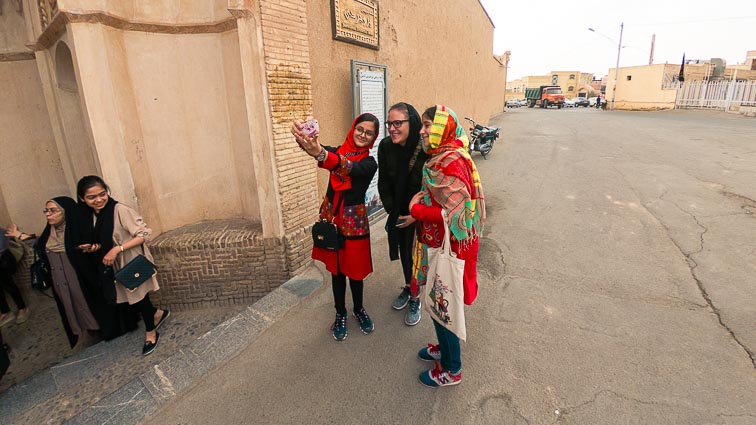

#7. Internet in Iran
When you backpack in Iran you will soon notice that many websites in Iran are blocked. Facebook, Twitter and Youtube are all not accessible. Even though Twitter is blocked in Iran, the website of the Iranian ministry of foreign affairs shows a Twitter button which links to the Twitter account of minister of foreign affairs, Javad Zarif. Either error or rebel, I think that’s pretty funny.
VPN (Virtual Private Network)
To circumvent this and still be able to use internet like it’s meant to, it’s advisable to get a VPN service. There are free VPN services, such as Touch VPN. You have to take into account that advertisements appear regularly and locations are limited. We bought VPN service at Express VPN for about $8 per month (for one year). ExpressVPN got recommended to us by friends. We can use these anywhere in the world. A VPN is also good for getting cheaper flights when connecting and searching from less wealthy countries.
Best 4G network in Iran
Because internet is not always the most stable and the fastest, it’s a good idea to get an Iranian sim card. After doing some research, we decided to go with Irancell. This provider has the best coverage and their prices are low as well. We got a sim card for 300,000 rial (about €7) with 20gb data which was valid for a month. Not too bad! There’s a chance you don’t have any reception in abandoned areas, but overall coverage is good and 4G is fast. We got our sim card at the Irancell service point in a metro station downtown.
#8. Accommodations in Iran
Booking accommodation in Iran is different from what you will expect from backpacking in other countries. If you want to stay in hostels or cheaper guesthouses there are a number of options for booking overnight stays:
- Almost all of our accommodations in Iran are booked through Hostelsiniran.com. The website seems a bit outdated, but after a booking they respond pretty fast. Hostelsiniran.com will check for you whether the room is available and send you an email in which they ask you to confirm your dates and details
- Although there are mainly expensive hotels on Booking.com, more and more guesthouses are also finding their way on Booking.com. One of our favorite guesthouses, for example, we booked via Booking.com. Varzaneh Traditonal Guesthouse in Varzaneh.
When you do not have about a good internet connection – internet is not always good in Iran – there will always be someone in the hostel who wants to help you with your booking. Ask a member of staff of the hostel where you will be staying at a hostel for your next destination and he will be happy to call and reserve you. - Although Couchsurfing is officially forbidden in Iran, this concept is very popular in Iran. Create a profile, indicate that you are going to Iran and invitations will be pouring in. Not only for ‘couches’, but also for drinking tea, chatting and tours. By far the cheapest way of staying in Iran.

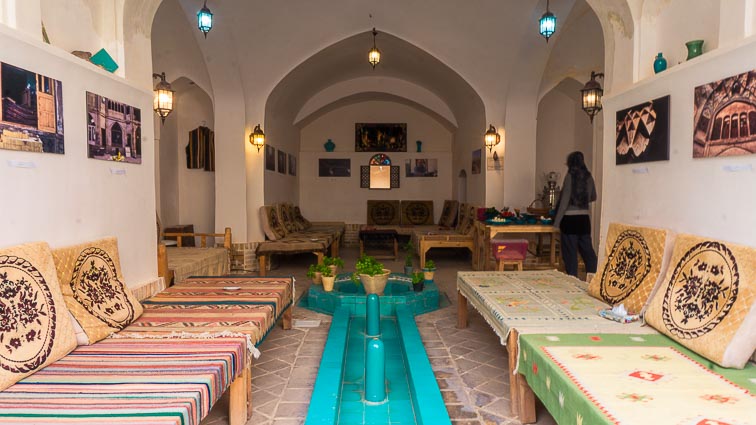

#9. The best Food and beverages
Some will say that the kitchen is boring, but our opinion is different. The Iranian food is delicious!
The best food in Iran
The food in Iran is not spicy, but they do use a lot of herbs. Especially saffron is used a lot in Iran. Vegetarians will generally have a slightly harder time as Iran has a meat eating culture. Iranians eat a lot of vegetables at home, but when they eat out, they often order meat. Kebab is one of the dishes that you will see on every menu. Often this is served with rice and bread (nan). Are you vegetarian, order a delicious falafel or a dish with eggplant like Mirza qasemi. In addition, Iranians love sour tastes. For example, we often received pickled vegetables with our dish which are extremely sour. And of course you should try the popular saffron ice cream that you can get in any city. Delicious!

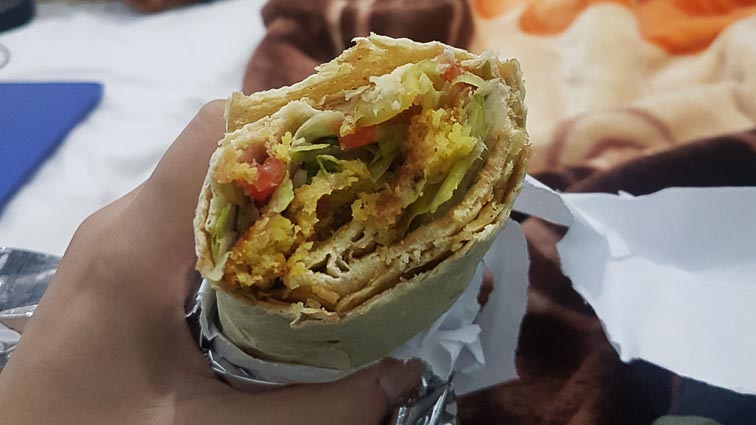
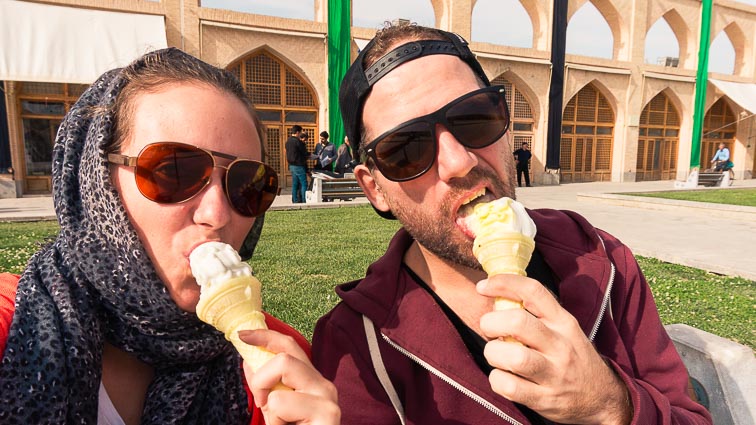
Drinks in Iran
Iranians love tea and drink it all day long. Preferably with a lot of sugar. Coffee is less popular, but more and more trendy coffee shops are popping up in the larger cities. Another drink that is drunk a lot is dough. A yogurt drink with spices. Esfahan is popular for its rose water. Alcohol is illegal in Iran. You will find alcohol-free beer everywhere in all kinds of fruity flavors. Even though it is forbidden, most Iranians do drink alcohol which they make at home or buy from an illegal brewery. To my question if I could fly the drone from the roof of the guesthouse I was answered: “Drones are forbidden in Iran….. But.. we do drink vodka even though it’s not allowed.”

#10. Getting around
There are multiple ways of backpacking in Iran; by public transport, hitchhiking or renting a car. We rented a car, so we have no experience about the other ways of transportation.
Backpacking in Iran by public transport
Even though we didn’t go by public transport ourselves, we’ve heard many good stories from other backpackers. The busses are cheap and comfortable. They go to almost every town, so you are quite flexible. If there are no busses to a certain destination, you have to take a taxi which can be quite expensive.
Hitchhiking
Along the road you’ll see plenty of people hitchhiking. To be honest we haven’t met any backpackers who traveled Iran by hitchhiking, but it definitely seems an option (and an adventure)
Renting a car
During our two week adventure in Iran we rented a car in Tehran which we dropped off in Shiraz. Renting a car is a very good way to explore Iran. You have the freedom of stopping where ever you want to take pictures, to have lunch or to talk to people. Definitely a very good way to see places no other tourist ever visits! Read more about car rental and traffic in Iran.
#11. Money Iran: All about money in Iran
In Iran, people pay with the Iranian rial. You can not obtain this currency anywhere in the world, which means that you have to change money on arrival in Iran. Take enough cash with you when you’re backpacking in Iran. Both euros and US dollars are easily exchangeable. We noticed that the exchange rate at the airport was even better than the exchange rate that Google indicated. At the airport we received 49,000 rials for one euro. This means that you get a big pile of money. Everyone knows that travelers walking with piles of cash. We have never felt insecure because of this. Larger cities are the best place to exchange money.
Read all about the cost of travel in Iran.
The Iranian Rial and the Toman
You will definitely get confused when you want to buy your first bottle of water. As told, Iran’s official currency is the Iranian rial. Iranians, however, often – almost always – talk about the toman. The toman is no other currency. One toman equals ten rial. Prices on menus are mostly in toman. We have asked many Iranians why they make it so difficult and everyone said that it is almost done alone because the amounts have too many zeroes. You will notice that Iranians understand that it is confusing. Sometimes they even take money from your hands because otherwise it takes too long. Do not worry. They will always be honest! At least that’s our experience. In 2016 the Iranian government officially agreed on replacing the rial with the toman. But for now the you’ll have to cope with the confusion.
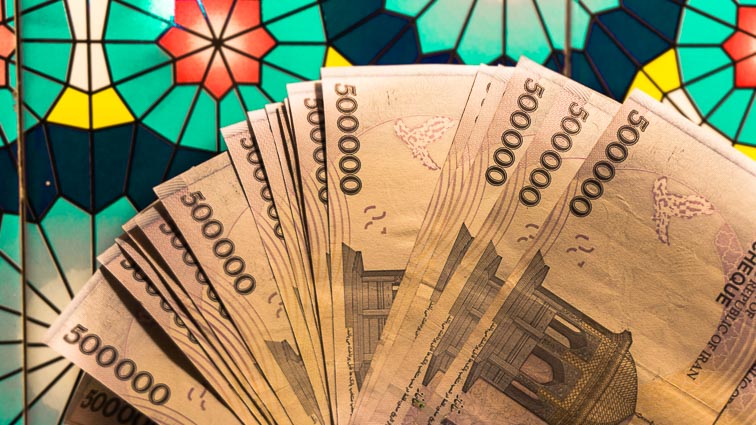
#12. Budget: How expensive is Iran?
Before our trip to Iran we read several articles on how much money we would spend in Iran. Soon after reading all these experiences we came to the conclusion that Iran would not me cheap to travel. However, our own experience is completely different. Iran is one of the cheapest countries we have been. The main cost item, by far, is accommodations. A double room with private bathroom costs around $40. Food is cheap and public transport is also very affordable. Tip for buying food: The dishes in Iran are very large and often one dish with two people is more than enough. Save that money for ice cream as dessert:) On average spent way less than 100 euros a day with the two of us.
Have you ever thought about backpacking in Iran?
